It is important to take a good look at the products you are using in your home and know how those ingredients may be harming your health.
I encourage you to take listen to these videos and then scroll through the information below to see more content on why you need to start making changes and how simple it can be. Read testimonies from others who have made the switch.
I encourage you to take listen to these videos and then scroll through the information below to see more content on why you need to start making changes and how simple it can be. Read testimonies from others who have made the switch.
Healthy Child Healthy World: A Wake-Up Story
Here is a video of me explaining why you need to look at your products for the sake of your health!
If you have any questions, please do not hesitate to ask them. I am here to help you step by step.
Look at me as a “100-hour head start” in learning how to implement this information into your daily life!

It is important to know what is in your laundry detergent!
When we are considering the health of our family, another area to take a closer look at are the products we are using in the laundry room. I encourage you to consider the ingredients in your laundry detergent. Once you have stopped using your old laundry detergent for even a month and you go back and try to breathe that stuff or anything that’s been washed in it, you will thank me. If for some reason, some article of our clothing gets washed in traditional detergents, I have to wash it multiple times to get that out before I’m comfortable with us using it. Just because it’s “free and clear” and you don’t smell fragrances, there can still be many of these other lurking ingredients.
Many families suffer from eczema, respiratory issues, cancer, sensory processing disorders, and autoimmune diseases that can be triggered or worsened by ingredients found in detergents. Your traditional laundry detergent needs to go. It is literally 24/7 exposure through your respiratory system and skin to horrible things your body has to work hard to process. The strain on your organs. The strain on your health.
"WHAT INGREDIENTS SHOULD I AVOID?
Many families suffer from eczema, respiratory issues, cancer, sensory processing disorders, and autoimmune diseases that can be triggered or worsened by ingredients found in detergents. Your traditional laundry detergent needs to go. It is literally 24/7 exposure through your respiratory system and skin to horrible things your body has to work hard to process. The strain on your organs. The strain on your health.
"WHAT INGREDIENTS SHOULD I AVOID?
- Fragrance: Manufacturers combine a number of chemicals to produce a fragrance—so you’ll believe your clothes are clean because they smell clean—and they don’t have to list those chemicals on the label because of trade protection. As we’ve seen, some of those chemicals can be very toxic.
- Cleaning agents (surfactants): These are included in the formula to help the product clean better. Examples include chemicals like quaternium-15 (known to release formaldehyde, a known carcinogen), diethanolamine (linked with skin and eye irritation and possibly liver problems), nonlphenol ethoxylate or NPE (toxic to nerves, irritating to the skin, a potential hormone disruptor, toxic to aquatic life), linear alkyl benzene sulfonates or LAS (irritating to skin and eyes and toxic to aquatic life; benzene on its own is a carcinogen), and petroleum distillates (linked to cancer and lung damage).
- Stabilizers: These chemicals help stabilize the formula so that it lasts longer on the shelf. Examples include polyalkylene oxide or ethylene oxide, which are linked with eye and lung irritation, and even dermatitis. And yet we wonder why we can’t clear up these lingering skin issues.
- Bleach: Bleach may be used separately or may be included in the detergent itself. It’s known to irritate skin, eyes, and lungs, and when it mixes with wastewater, it can form toxic organic compounds that have been linked with respiratory issues, liver, and kidney damage. 1,4-dioxane: This is a chemical by-product of detergent manufacturing. In independent tests, Women’s Voices for the Earth found 89 parts per million (ppm) in Tide Free & Gentle and 63 ppm in regular Tide. They helped increase awareness, and Proctor & Gamble agreed to reformulate to reduce levels to below 25 ppm. Future tests should show whether they made good on that promise. Don’t have a lot of confidence in the progress being made here.
- Brighteners: You’ll find these in detergents advertising their “brightening” powers. Brighter whites! Brighter colors! What’s creating all this brightness? Chemicals that actually remain on the clothes to absorb UV light and help clothes “appear” brighter. We’re talking about things like naphthotriazolystilbenes (linked with developmental and reproductive effects), benzoxazolyl, diaminostilbene disulfonate, and more. Since these remain on the clothes, they are likely to come into contact with skin.
- Phosphates & EDTA: Manufacturers use these to make detergents more effective in hard water, and to help prevent dirt from settling back on clothes when they’re washing. These chemicals have long been associated with environmental damage, particularly in our streams and waterways. They cause algae blooms that damage ecosystems. Many detergents have eliminated these, but they’re often using ethylene diamine tetraacetic acid (EDTA) in its place, which does not readily biodegrade, and has been found to be toxic in animal studies.
Even though it was hard to break away from the detergent I had used for years, I knew that switching to Thieves Laundry Soap was right for me. Ask yourself, “is my health worth at least TRYING this out for a little while?” I know you can make the commitment."
I encourage you to look at the ingredients in your current laundry detergent. Go to Google.com and type in 'dangers of....' and see what you find. Remember that ingredients are listed starting with the one that is in the highest quantity to the least. Also the word 'fragrance' can contain hundreds of chemicals, even non-scented products may have the ingredient 'fragrance' in the list. They will add additional chemicals to cover up the smell. You may think you are picking a safe product but the marketing can be misleading.

A LEGENDARY FORMULA
Young Living’s Thieves essential oil blend was inspired by a 15th-century story of thieves who formulated and wore a special aromatic combination of clove, rosemary, lemon, and other rich and spicy botanicals they believed would provide protection while robbing the bodies of those inflicted with the black plague.
French authorities recognized that there were amazing benefits and value in the thieves’ mixture. Upon their capture, the thieves received a lighter punishment on the condition that the secrets of their formula were revealed.
This powerful blend is used today and can be found in all of Young Living Thieves products. The spicy, welcoming aroma will be your new best friend. Everything from cleaning countertops, to dishes, to your teeth all with the guaranteed safety of a plant-based, safe formula.

So what is in this magical blend of immune-boosting goodness?
Clove Essential Oil
• Nature’s richest source of eugenol
• Highest scoring single ingredient tested for its antioxidant/ORAC capacity
• Known for its immune-enhancing properties
Lemon Essential Oil
• Powerful antioxidant agent
• Contains 68% d-limonene
• Widely used as a natural solvent and cleanser
Rosemary Essential Oil
• Shown to possess antimicrobial properties
• Supports mental alertness
• Fights mental fatigue
Cinnamon Bark Essential Oil
• Rich in antioxidants
• Research shows it possesses antimicrobial abilities
• Supports the digestive system
Eucalyptus Radiata Essential Oil
• Versatile and health-promoting
• Contains powerful eucalyptol compound
• Lab tests show it’s effective against bacteria

When consumers buy commercial cleaning products, we expect them to do one thing: clean!
We use a wide array of scents, soaps, detergents, bleaching agents, softeners, scourers, polishes, and specialized cleaners for bathrooms, glass, drains, and ovens to keep our homes sparkling and sweet-smelling. However, while the chemicals in cleaners foam, bleach, and disinfect to make our dishes, bathtubs and countertops gleaming and germ-free, many also contribute to indoor air pollution, are poisonous if ingested, and can be harmful if inhaled or touched. In fact, some cleaners are among the most toxic products found in the home. In 2000, cleaning products were responsible for nearly 10% of all toxic exposures reported to U.S. Poison Control Centers, accounting for 206,636 calls. Of these, 120,434 exposures involved children under six, who can swallow or spill cleaners stored or left open inside the home. Cleaning ingredients vary in the type of health hazard they pose. Some cause acute, or immediate, hazards such as skin or respiratory irritation, watery eyes, or chemical burns, while others are associated with chronic, or long-term, effects such as cancer.
The most acutely dangerous cleaning products are corrosive drain cleaners, oven cleaners, and acidic toilet bowl cleaners, according to Philip Dickey of the Washington Toxics Coalition. Corrosive chemicals can cause severe burns on the eyes, skin and, if ingested, on the throat and esophagus. Ingredients with high acute toxicity include chlorine bleach and ammonia, which produce fumes that are highly irritating to the eyes, nose, throat, and lungs, and should not be used by people with asthma or lung or heart problems. These two chemicals pose an added threat in that they can react with each other or other chemicals to form lung-damaging gases. Combining products that contain chlorine and ammonia or ammonia and lye (in some oven cleaners) produces chloramine gases, while chlorine combined with acids (commonly used in toilet bowl cleaners) forms toxic chlorine gas.
Fragrances added to many cleaners, most notably laundry detergents and fabric softeners, may cause acute effects such as respiratory irritation, headache, sneezing, and watery eyes in sensitive individuals or allergy and asthma sufferers. The National Institute of Occupational Safety and Health has found that one-third of the substances used in the fragrance industry are toxic. But because the chemical formulas of fragrances are considered trade secrets, companies aren’t required to list their ingredients but merely label them as containing “fragrance.”
Other ingredients in cleaners may have low acute toxicity but contribute to long-term health effects, such as cancer or hormone disruption. Some all-purpose cleaners contain the sudsing agents diethanolamine (DEA) and triethanolamine (TEA). When these substances come into contact with nitrites, often present as undisclosed preservatives or contaminants, they react to form nitrosamines - carcinogens that readily penetrate the skin. 1,4-dioxane, another suspected carcinogen, may be present in cleaners made with ethoxylated alcohols. Butyl cellosolve (also known as ethylene glycol monobutyl ether), which may be neurotoxic (or cause damage to the brain and nervous system), is also present in some cleaners.
Chemicals that are so-called “hormone disruptors” can interfere with the body’s natural chemical messages, either by blocking or mimicking the actions of hormones. Possible health effects include decreased sperm counts, increased rates of male birth defects such as cryptorchidism (undescended testicles) and hypospadias (where the urethra is on the underside of the penis), and increased rates of some kinds of cancers. The alkylphenol ethoxylates (APEs) used in some detergents and cleaners have been shown to mimic the hormone estrogen; one APE, p-nonylphenol, has caused estrogen-sensitive breast cancer cells to multiply in a test tube study.”
What about you? Are you going to SWITCH to the amazing benefits of Thieves Household Cleaner?
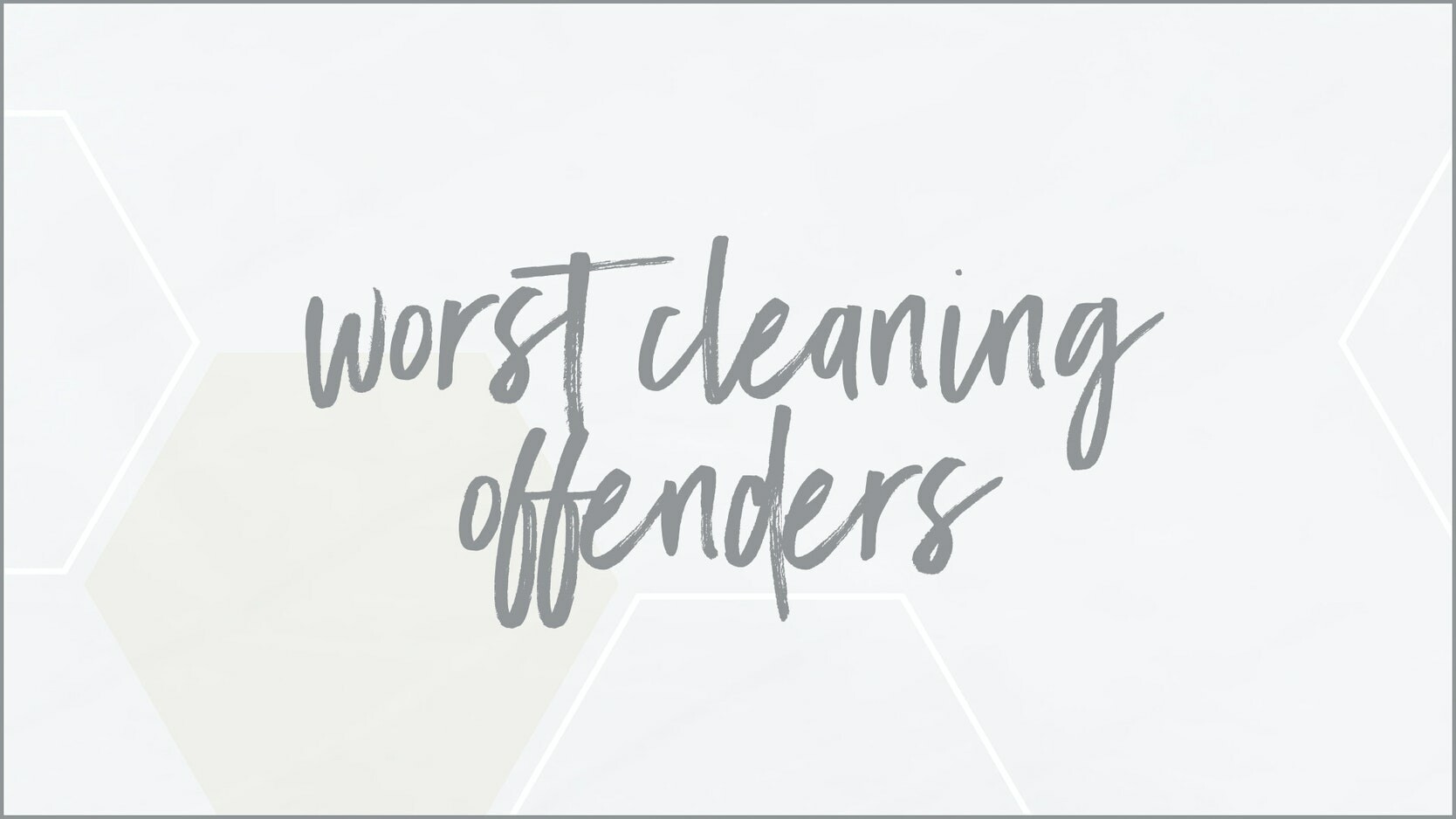
Want to see some of the worst offenders?
We talked about some of the hazardous ingredients present inside our cabinets, hiding in our household cleaners. Want to see some of the worst offenders according to EWG at the time of this writing? You might be surprised.
Rated F (highest hazard rating): Ajax, Charlie's Soap, Clorox, CVS, Green Works, Lysol, Mr. Clean, Pledge, Safeway, Scrubbing Bubbles, Simple Green, Soft Scrub, SOS, Swiffer, Tilex, Trader Joe's, Up & Up, Wal Mart, Windex
Okay, it's time to get it out. If you haven't already made the switch, I want you to clean out those cabinets and show us as you DITCH those horrible options and start cleaning with your oils!
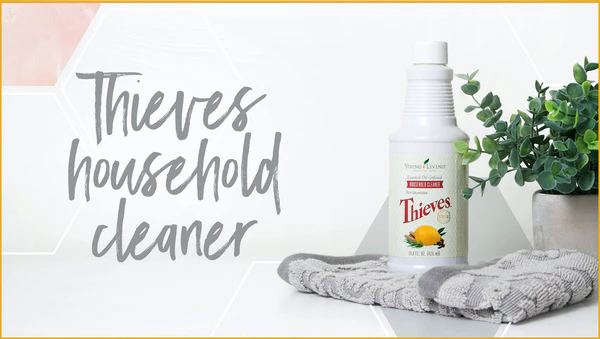
A SAFER WAY TO CLEAN
Thieves Household cleaner provides that deep clean we all crave without dangerous ingredients. Wherever you choose to use it, you will feel good knowing this product is safe to use around everyone in your family. The heavily concentrated and versatile formula makes this one a must-have in your home. In case you were wondering, the entire plant-based formula contains no soy or animal products. I knew you would get excited over that fact!
Thieves Household Cleaner is safe to use on various surfaces including windows, refinished porcelain, glass, granite, stainless steel, copper, cast iron, or varnished wood. However, Thieves cleaner is not intended for cleaning vinyl or soft plastic surfaces.
Pro Tip: do a spot test on the desired surface. Wait 5 min and then be amazed at how gentle it is to clean ALL your surfaces.
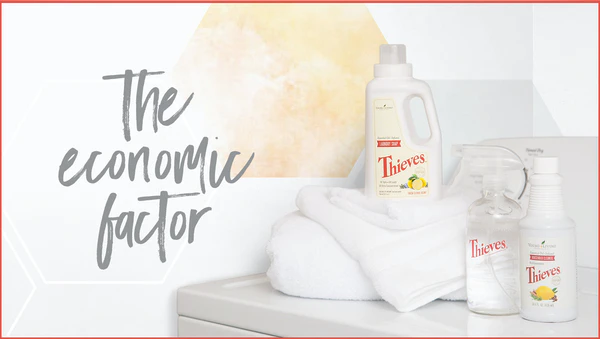
LET’S TALK SAVING MONEY
Friends don’t let friends overspend. We can’t go any further without me explaining how this is the most cost-effective non-toxic cleaner on the market. Just erase any perceived thoughts that living a toxin-free life needs to be expensive.
Thieves Household Cleaner can and will replace ALL other cleaning products, saving you time and money, and space under your sink. Thieves Cleaner comes in a concentrate, so all you have to do is add an ounce of cleaner to a 32oz spray bottle with water & you’re good to go! It’s that easy! Below is an easy dilution chart for you to reference as you dive headfirst into a toxin-free home.
Before I made the swap to Thieves Cleaner, I thought that it was really expensive to have a safe cleaning product. I was wrong!! The "greenwashed" cleaners that actually still contain harmful ingredients cost far more!
Let’s compare All-Purpose cleaners:
•7th Generation $0.27 per ounce
•Green Works $0.22 per ounce
•Method $0.21 per ounce
•Lysol $0.17 per ounce
•Clorox Clean-Up $0.16 per ounce
•Clorox Clean-Up $0.16 per ounce
•No-Name brand $0.07 per ounce
•Thieves Household Cleaner $0.06 per ounce
Completely safe, effective, and usable for everything in your home, you'll never need anything else!
Do your wallet a favor and stop paying for those so-called "natural" cleaners that are still full of yuck and are costing you far more!!!
One of the best parts about swapping to a plant-based, toxin-free lifestyle is that you can make many of the items yourself for a fraction of the cost!
Dilution Ratios
Light Degreasing (1:60)
1 capful cleaner to 4 cups water
•Thieves Household Cleaner $0.06 per ounce
Completely safe, effective, and usable for everything in your home, you'll never need anything else!
Do your wallet a favor and stop paying for those so-called "natural" cleaners that are still full of yuck and are costing you far more!!!
One of the best parts about swapping to a plant-based, toxin-free lifestyle is that you can make many of the items yourself for a fraction of the cost!
Dilution Ratios
Light Degreasing (1:60)
1 capful cleaner to 4 cups water
Medium Degreasing (1:30)
1 capful cleaner to 2 cups water
1 capful cleaner to 2 cups water
Heavy Degreasing (1:15)
1 capful cleaner to 1 cup water
1 capful cleaner to 1 cup water
Pot & Pans (1:100)
1/2 capful cleaner to 3 cups water
Hand Cleaner (1:1)
1/2 cup cleaner to 1/2 cup water
Floors (1:100)
1 capful cleaner to 6 1/2 cup water
Walls (1:30)
1 capful cleaner to a little less than 2 cups water
Fabric & Carpet (1:40)
1 capful cleaner to 2 cups water
Glass (1:320)
1 capful water to 5 quarts water
Laundry
1 capful per load in place of detergent

Here are some testimonies from other members!
I may not actually be able to DO the flips. But, in my head, I'm a Thieves-wielding mama superhero, and so many of you are too! Let's be honest. This is what we all feel like inside after we've broken out the powerful and empowering Thieves Cleaner.
--//--
This is the only cleaner I use in my house! We use it for literally everything!
It's the only cleaner I have found that doesn't irritate my skin or asthma!
Best cleaner ever😍
--//--
Thieves cleaner is amazing!! Years and years of hard water build-up all gone from this powerful cleaner 🤯
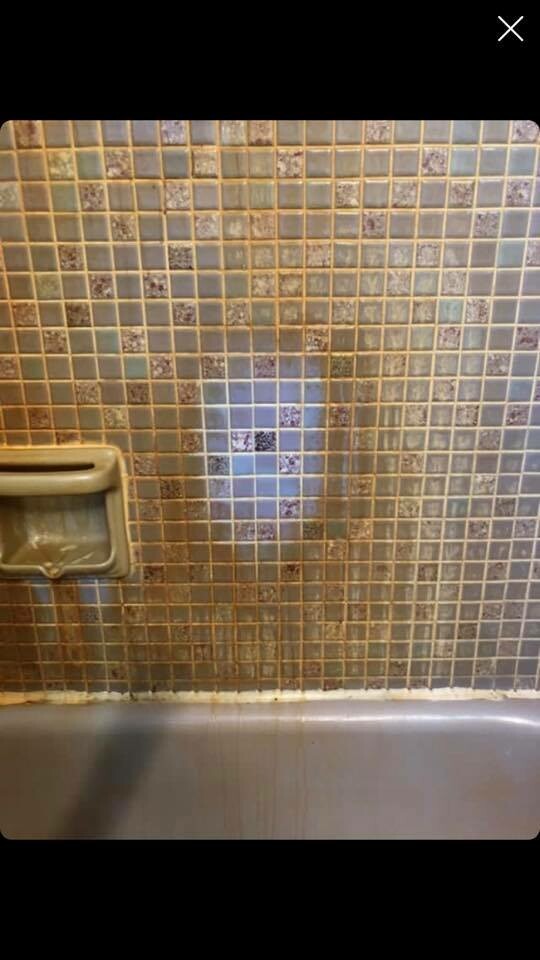
--//--
I don’t cough or hold my breath when I clean anymore. so that’s pretty cool. 😂💁🏻♀️
--//--
The only cleaner I trust, I have a 16-month son and he licks the whole house. So I’m thankful I clean everything from our floors to the walls, to his toys, to my hair with this cleaner!!!!!
So versatile and safe.
--//--
I just love it for my floors then my whole house smells amazing! My mom couldn’t resist asking me for a sample to try at home recently when she said my house smelled so good 🥰
--//--
This tub I thought we were going to need to replace! Thieves tub scrub & you’d never know it was ever like this!!
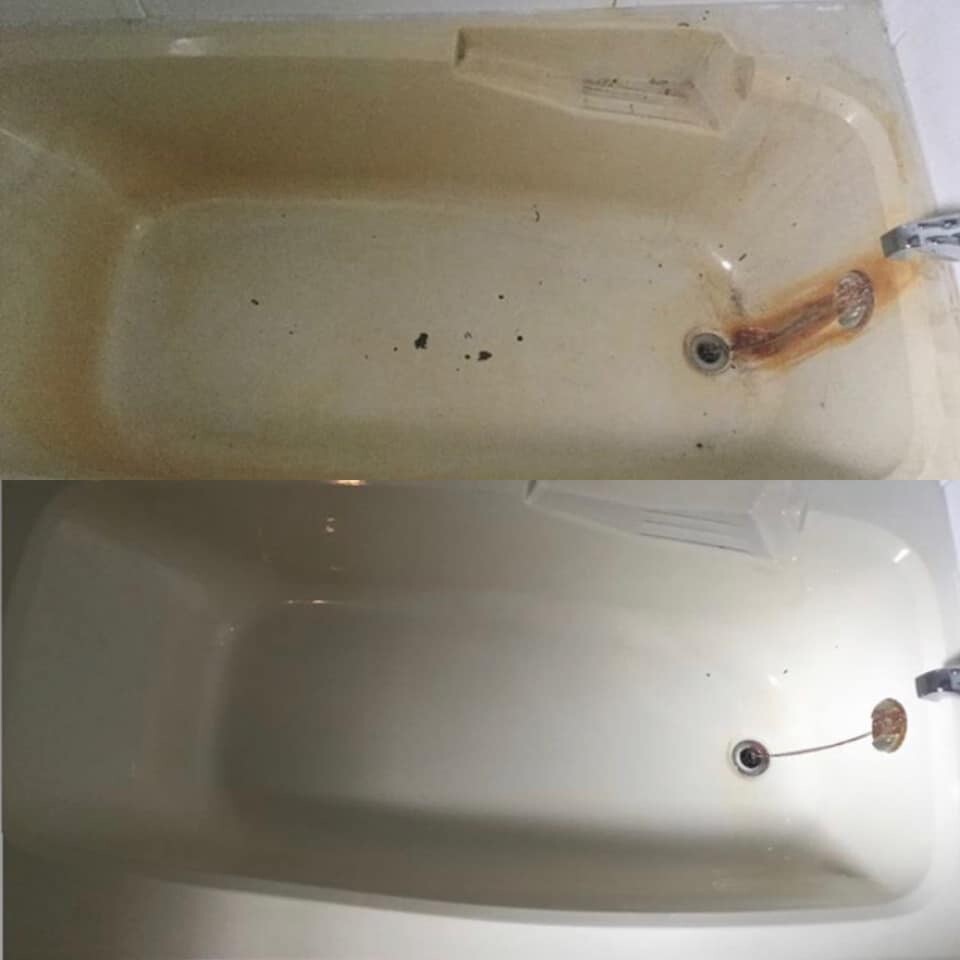
You’re seriously not asking this question
Rhonda
😂 You know my eternal love for Thieves!🥰
--//--
Besides my stepson running into the house and coming to a dead stop, inhaling and saying” I love the smell of home”, using it to clean ovens!!! Just spray directly on burned on gunk sprinkle baking soda and let sit for 20 mins and literally wipe with a damp cloth!! No heat and just the beautiful aroma of thieves!!!
--//--
I can’t remember using anything else🤣🤣
Selective memory??
Old age??
Don’t care
Not using anything else....EVER!
Sold my husband on it when he cleaned his precious BBQ and it shone after!
With no scrubbing required!
--//--
This is the only cleaner I use in my house! We use it for literally everything!
It's the only cleaner I have found that doesn't irritate my skin or asthma!
Best cleaner ever😍
--//--
Thieves cleaner is amazing!! Years and years of hard water build-up all gone from this powerful cleaner 🤯

--//--
I don’t cough or hold my breath when I clean anymore. so that’s pretty cool. 😂💁🏻♀️
--//--
The only cleaner I trust, I have a 16-month son and he licks the whole house. So I’m thankful I clean everything from our floors to the walls, to his toys, to my hair with this cleaner!!!!!
So versatile and safe.
--//--
I just love it for my floors then my whole house smells amazing! My mom couldn’t resist asking me for a sample to try at home recently when she said my house smelled so good 🥰
--//--
This tub I thought we were going to need to replace! Thieves tub scrub & you’d never know it was ever like this!!

--//--
Rhonda
😂 You know my eternal love for Thieves!🥰
--//--
Besides my stepson running into the house and coming to a dead stop, inhaling and saying” I love the smell of home”, using it to clean ovens!!! Just spray directly on burned on gunk sprinkle baking soda and let sit for 20 mins and literally wipe with a damp cloth!! No heat and just the beautiful aroma of thieves!!!
--//--
I can’t remember using anything else🤣🤣
Selective memory??
Old age??
Don’t care
Not using anything else....EVER!
Sold my husband on it when he cleaned his precious BBQ and it shone after!
With no scrubbing required!
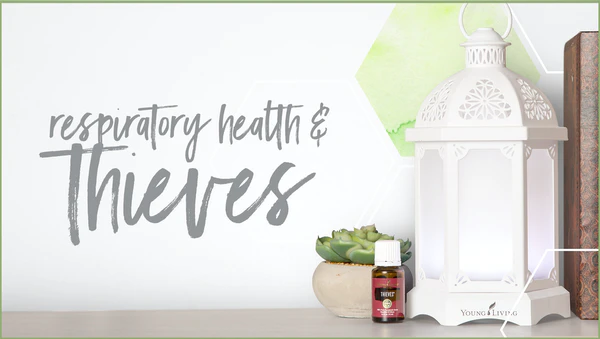
Let’s look at respiratory health next.
We have been looking at Thieves products to help you target different areas of your health. Let’s look at respiratory health next.
Many additives found in household products can make it difficult for our bodies to operate at their best. Oftentimes the majority of the stress is on the respiratory system. The beauty of essential oil products is that they not only help you clean to get the job done, but they support your body in the way it was designed rather than putting your body at risk and stressing the lungs. Remember that all the systems of your body work together in harmony. Every piece of your health affects another.
I hope you are giving your body a break. That you are breathing cinnamony, oily goodness instead of the unknown and undefined “fragrance” in products that are even marketed as green and clean.
Do yourself a favor!
Top 3 changes to support Respiratory Health
1. Thieves Household Cleaner vs. traditional cleaners
2. Thieves Oil diffused vs. candles and freshener sprays
3. Thieves Laundry Soap vs. traditional detergents
Many additives found in household products can make it difficult for our bodies to operate at their best. Oftentimes the majority of the stress is on the respiratory system. The beauty of essential oil products is that they not only help you clean to get the job done, but they support your body in the way it was designed rather than putting your body at risk and stressing the lungs. Remember that all the systems of your body work together in harmony. Every piece of your health affects another.
I hope you are giving your body a break. That you are breathing cinnamony, oily goodness instead of the unknown and undefined “fragrance” in products that are even marketed as green and clean.
Do yourself a favor!
Top 3 changes to support Respiratory Health
1. Thieves Household Cleaner vs. traditional cleaners
2. Thieves Oil diffused vs. candles and freshener sprays
3. Thieves Laundry Soap vs. traditional detergents
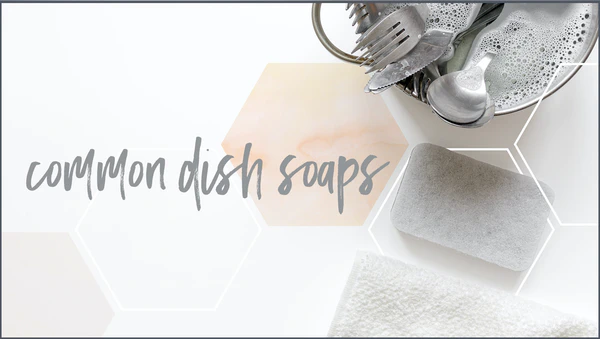
We CANNOT forget the other very important and daily soap we all use. Dish soap!
DISH SOAP INGREDIENTS Have you ever looked at the ingredients in your dish soap? If you have, you may have seen these ingredients:
- Ammonium C12-15 Pareth Sulfate: Evidence of chronic aquatic toxicity; damage to DNA; respiratory effects
- Lauramidopropylamine Oxide: Evidence of respiratory effects; skin irritation/allergies/damage; damage to vision
- DMDM Hydantoin (also known as formaldehyde): Evidence of cancer; skin irritation/allergies/damage; general systemic/organ effects
- Sodium Bisulfate: Evidence of damage to vision
- Methylchloroisothiazolinone: Evidence of acute aquatic toxicity; skin irritation/allergies/damage
Personally, these side effects raise lots of red flags for me. When we are exposed to harmful ingredients over the course of many years, it can cause serious wear and tear on our bodies.
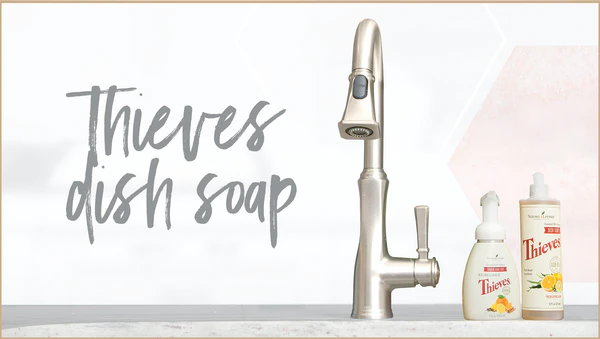
Ready to make the switch for the safety of your skin and eating surfaces? We love our Thieves Dish Soap!
INGREDIENTS
- Decyl glucoside: Comparable to the other Alkyl Polyglucoside Surfactants, decyl glucoside is obtained from 100% renewable vegetable origin. The Cosmetic Ingredient Review (CIR) Expert Panel assessed the safety of 19 alkyl glucosides including decyl glucoside as used in cosmetics and concluded that these ingredients are safe in the present practices of use and concentration when formulated, and are non-irritating. Since glucoside hydrolases in human skin are likely to break down these ingredients to release their respective fatty acids and glucose, the Panel also reviewed CIR reports on the safety of fatty alcohols and were able to extrapolate data from those previous reports to support safety. Decyl glucoside is a gentle cleanser delicate enough even for the delicate skin on fruits, such as berries and cherry tomatoes, which is why it is used in Fruit & Veggie Sprays also.
- Sodium lauroyl lactylate: A salt derived from the lauric acid ester of lactyl lactate (or milk and coconut oil), and is traditionally used as a food emulsifier, although it is seen in cosmetics and personal care products because of its ability, as a lactylate, to penetrate skin easily, providing “residual moisturization, extended fragrance release, and enhanced delivery of actives. Lauric acid is known for its moisturizing abilities, and is also recognized as an acne-fighter thanks to its antimicrobial properties. Sodium Lauroyl Lactylate is used as an ingredient in shampoos, face and body washes, and other foaming cleansers.
- Lauryl glucoside and caprylyl glucoside: a safer alternative to regular harsh sulfates, which are typically used in cleansers to make the formula foam up. Also a “surfactant (cleanser),” this one is formed in the lab by blending a mixture of alcohols with some simple sugars. The raw materials come from vegetables or coconut, and the resulting ingredient has a “zero” hazard rating on the Skin Deep Database.
- Sodium oleate: I honestly had a difficult time finding information on this one that was not extremely scientific and technical and mixed with other ingredients. EWG rates it very low and lists 18 studies showing it to be of low concern on several fronts like estrogenic and mutagenic effects.
- Sodium sesquicarbonate: An A rating on EWG, this ingredient is a double salt of sodium bicarbonate and sodium carbonate, and has a needle-like crystal structure. However, the term is also applied to an equimolar mixture of those two salts, with whatever water of hydration the sodium carbonate includes, supplied as a powder.
My favorite aspect of every Young Living product is that instead of the vague “fragrance” that they don’t even have to disclose to us, we know that we have the most amazing, cleansing, pure essential oil scents which also have health benefits.
Have you made the swap?

MINUS the synthetic FRAGRANCES and TRICLOSAN
Wash your hands frequently (avoiding fragranced and antibacterial soaps), and always before eating. You’ll rinse a substantial amount of chemical residue down the drain. There are even significant amounts of chemicals on things like receipts when you pay for your food.
The key here is what is in your soap. If you're putting chemicals right back on (you know that lingering really strong fragrance after you wash your hands with that pink public bathroom soap), you're not helping yourself out here.
Antibacterial soaps (which you will find almost everywhere) include an ingredient called Triclosan. Triclosan is a known endocrine disruptor and a suspected carcinogen. There is good reason to believe that the overuse of products with triclosan has contributed to bacterial resistance in the same way we are cautioned against the use of antibiotics. The persistent nature is connected to the use of triclosan being washed down our drains daily and affecting water life.
Triclosan is also lipophilic, which means it can bioaccumulate in your fat for long periods of time, and as reported by Scientific American, triclosan is now detectable in human breast milk, blood, and urine samples. Environmental Health Perspectives (EHP) found the chemical in 75% of urine samples tested for a study focused on triclosan. And furthermore, the Center for Disease Control and Prevention detected triclosan in 58% of US waterways.
According to the FDA, "Animal studies have shown that triclosan alters hormone regulation. Other studies in bacteria have raised the possibility that triclosan contributes to making bacteria resistant to antibiotics. In light of these studies, the FDA is engaged in an ongoing scientific and regulatory review of this ingredient."
We have good bacteria as well as bad on our skin and as our largest organ, it can serve to keep our immune systems strong if we don't completely break them down and leave ourselves unprotected.
SWAP: Thieves Foaming Hand Soap
You can't get a more easy button than this. Buy a 3-pack or get your own foaming containers and buy the refills. Pour it in and wash those hands! Or, you can have all kinds of fun adding scents to your foaming soap like pine, geranium, orange, or lemon. The sky is the limit to your creativity to combine your oils with this ready-to-go product! You'll love how soft and moisturized your hands stay even with all that washing due to the absence of sulfates, dyes, synthetic fragrances, and harsh chemicals.
- Thieves Foaming Hand Soap 3pk 3643
- Thieves Foaming Hand Soap 8oz 3674
- Thieves Foaming Hand Soap Refill 32 oz 3594
- They even make these tiny containers you can keep in your purse for using your foaming soap on the go! https://tinyurl.com/vx8yzg4
And don't forget your Thieves Hand Sanitizer!
- Thieves Hand Sanitizer - 7.6oz 7.6oz 5142
- Thieves Waterless Hand Sanitizer 1 oz 3621
- Thieves Waterless Hand Sanitizer 3 pk 3622
Have you already made this swap? Have you made sure the soap you and your children are using isn't full of harmful fragrances, toxins, and antibacterial chemicals?

Have you ever read the fine print on a tube of supermarket toothpaste?
In many tubes you’ll notice our villains, sodium lauryl sulphate, fluoride (which the EPA lists as a contaminant. It’s considered a “toxic waste” in the fertilizer industry). “Use a pea-sized amount. Do not swallow. Contact poison control if you do.” It’s downright scary! And we’re putting this substance in our mouth, into the mouth of our kids (who we all know will accidentally swallow anything). According to the Physician’s Desk Reference, the mucosal lining inside of the mouth has an absorption efficiency of over 90 percent. Because of this, these carcinogens can get into your blood, brain, and cells in no time at all—especially when you consider that most people use dental-care products 2 to 3 times a day.
Don't forget the growing fluoride concerns of those in the health industry.
Thieves to the rescue! Thieves toothpastes are great alternatives to supermarket toothpastes. Thieves toothpastes contain all-natural, plant derived ingredients like Peppermint, Wintergreen, and Thieves, along with odor absorbing baking soda, and of course they are nontoxic! They are also free of SLS, which is a major mouth irritant and can cause canker sores.
Crazy Oiler Tip: Try AromaBright Toothpaste topically as a deodorant!
Are you ready to make the toothpaste DITCH and SWITCH? Time to watch more closely what goes into your mouth each day!
Thieves AromaBright Flavor: Sweet Mint AromaBright gently brushes away daily buildup and helps combat the effects of unsightly staining. It’s tough on buildup, but its smooth, plant- based formula is gentle on teeth and their delicate enamel.
Thieves Whitening Flavor: Fresh Spearmint Pure and safe ingredients combine to whiten teeth, fight plaque, support healthy gums, and remove stains without damaging enamel.
KidScents Slique Flavor: Citrus- Slique This fruity-flavored toothpaste gently cleans teeth with a safe, naturally derived formula specially created for children.
Don't forget the growing fluoride concerns of those in the health industry.
Thieves to the rescue! Thieves toothpastes are great alternatives to supermarket toothpastes. Thieves toothpastes contain all-natural, plant derived ingredients like Peppermint, Wintergreen, and Thieves, along with odor absorbing baking soda, and of course they are nontoxic! They are also free of SLS, which is a major mouth irritant and can cause canker sores.
Crazy Oiler Tip: Try AromaBright Toothpaste topically as a deodorant!
Are you ready to make the toothpaste DITCH and SWITCH? Time to watch more closely what goes into your mouth each day!
Thieves AromaBright Flavor: Sweet Mint AromaBright gently brushes away daily buildup and helps combat the effects of unsightly staining. It’s tough on buildup, but its smooth, plant- based formula is gentle on teeth and their delicate enamel.
Thieves Whitening Flavor: Fresh Spearmint Pure and safe ingredients combine to whiten teeth, fight plaque, support healthy gums, and remove stains without damaging enamel.
KidScents Slique Flavor: Citrus- Slique This fruity-flavored toothpaste gently cleans teeth with a safe, naturally derived formula specially created for children.

There are so many awful things lurking in your oral hygiene.
Let's make sure that you aren't working on cleaning your body out and swishing awful ingredients at the same time!
After you've done hard work to get the toxins out of your body, DON'T put them back in!!!! Do just a bit of research on some of the ingredients in traditional toothpaste, especially children's toothpaste, and you will run in horror to dispose of all bottles of danger lurking in your bathroom cabinets, drawers, and secret behind the mirror spaces.
My dentist fully supports my use of the Young Living Thieves line of dental care. She referred to my dental hygiene as "immaculate." Woohoo!!! She also noticed that it seems to make teeth much less sensitive and is recommending it for that reason as well. Missing the toxic hazardous waste, what our extensive line of toothpaste, floss, and mouthwash does have is the Thieves blend, full of immune support and bacteria-fighting capabilities. It's time to ditch the junk and stop pouring more chemicals into your mouth multiple times a day. Instead, do something to support your immune system, gut, and to promote healthy teeth and gums.
Bonus: Gargling Thieves mouthwash does wonder for soothing your throat due to its colloidal silver and Thieves toothpaste makes a great backup deodorant!
Double Bonus: Try adding a drop of Orange Oil to your Thieves toothpaste each day to whiten your teeth!
Do you love your Thieves oral care products? Which one is YOUR favorite?
After you've done hard work to get the toxins out of your body, DON'T put them back in!!!! Do just a bit of research on some of the ingredients in traditional toothpaste, especially children's toothpaste, and you will run in horror to dispose of all bottles of danger lurking in your bathroom cabinets, drawers, and secret behind the mirror spaces.
My dentist fully supports my use of the Young Living Thieves line of dental care. She referred to my dental hygiene as "immaculate." Woohoo!!! She also noticed that it seems to make teeth much less sensitive and is recommending it for that reason as well. Missing the toxic hazardous waste, what our extensive line of toothpaste, floss, and mouthwash does have is the Thieves blend, full of immune support and bacteria-fighting capabilities. It's time to ditch the junk and stop pouring more chemicals into your mouth multiple times a day. Instead, do something to support your immune system, gut, and to promote healthy teeth and gums.
Bonus: Gargling Thieves mouthwash does wonder for soothing your throat due to its colloidal silver and Thieves toothpaste makes a great backup deodorant!
Double Bonus: Try adding a drop of Orange Oil to your Thieves toothpaste each day to whiten your teeth!
Do you love your Thieves oral care products? Which one is YOUR favorite?
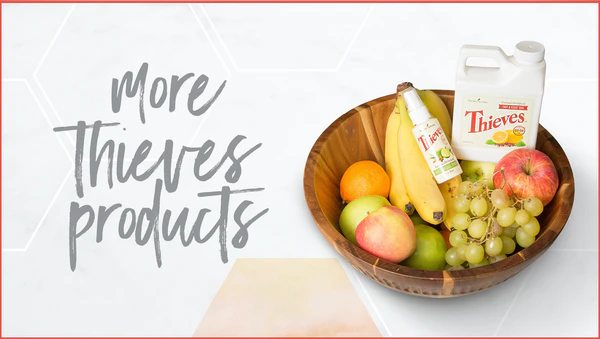
If you’re loving everything so far, you’ll love this next part.
There are actually over 25+ Young Living products that use the power of Thieves to safely clean and protect your family.
Thieves Fruit & Veggie Soak and Spray
The Thieves Fruit & Veggie Soak is perfect for adding to a sink full of water and soaking all your produce before putting it away. Prepare to be amazed at the dirty residue that lurks in the water after washing, even with organic products from the grocery store.
Take the Thieves Fruit & Veggie Spray on the go and give apples a quick spray and wipe before biting into them.
Thieves Waterless Hand Sanitizer
While we are talking about cleaning our produce, let’s not forget to clean our hands before touching the food we consume. Thieves Hand Sanitizer is the perfect size to tuck in your pockets, purses, or keep on the kitchen counter.
Thieves Spray
Thieves Spray is another great product for taking with you on the go. Just one small spray freshens counters, sinks, door handles, toilets, and more.
Thieves Dish Soap
Don’t forget the pot and pan clean-up after cooking meals for your family. One drop goes a long way with this concentrated dish soap.
Thieves Fruit & Veggie Soak and Spray
The Thieves Fruit & Veggie Soak is perfect for adding to a sink full of water and soaking all your produce before putting it away. Prepare to be amazed at the dirty residue that lurks in the water after washing, even with organic products from the grocery store.
Take the Thieves Fruit & Veggie Spray on the go and give apples a quick spray and wipe before biting into them.
Thieves Waterless Hand Sanitizer
While we are talking about cleaning our produce, let’s not forget to clean our hands before touching the food we consume. Thieves Hand Sanitizer is the perfect size to tuck in your pockets, purses, or keep on the kitchen counter.
Thieves Spray
Thieves Spray is another great product for taking with you on the go. Just one small spray freshens counters, sinks, door handles, toilets, and more.
Thieves Dish Soap
Don’t forget the pot and pan clean-up after cooking meals for your family. One drop goes a long way with this concentrated dish soap.

Take advantage of the Thieves Essential Rewards Kit!
If you are already a member of Young Living, first of all, please tell me you are on Essential Rewards earning points back on your monthly purchases. Second, I hope you have been taking advantage of the Thieves Essential Rewards Kit! This kit will save you $38 by bundling these favorite items together. You could order this kit once a year, several times a year, or every month depending on quickly you need to replace the items.
- Thieves Essential Oil, 5 ml
- Thieves Dish Soap, 12 fl oz
- Thieves Foaming Hand Soap - Single, 8 fl oz (pump included)
- Thieves Household Cleaner, 14.4 fl oz
- Thieves Laundry Soap, 32 fl oz
- Thieves Fruit & Veggie Spray, 2 fl oz
- Thieves Waterless Hand Purifier - Single, 1 oz
- Thieves Aromabright Toothpaste, 4 oz*
Depending on what level of earning you are at with Essential Rewards you could also be earning 10, 20, even 25% rewards points on the PV value with the purchase of the Thieves ER Kit! Hello, that is like paying yourself to keep a clean home!
Are you ready to get started?
You can purchase one product or save more by getting a bundle.
The choice is yours! Do you have more questions?

 Download my free guide today!
Download my free guide today!